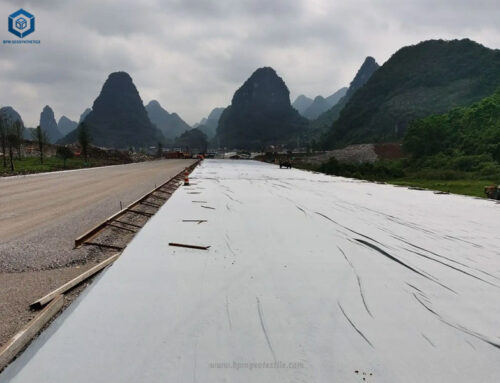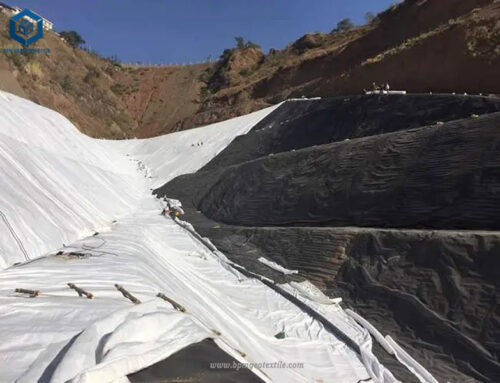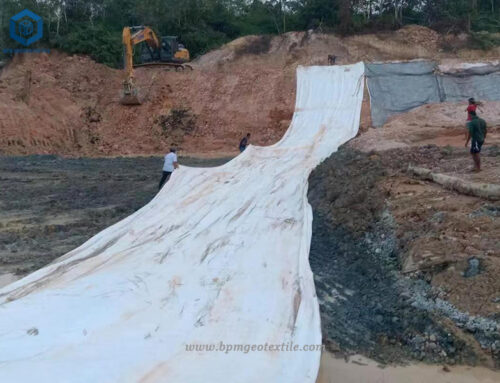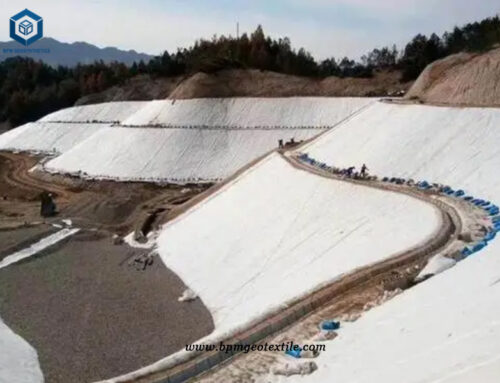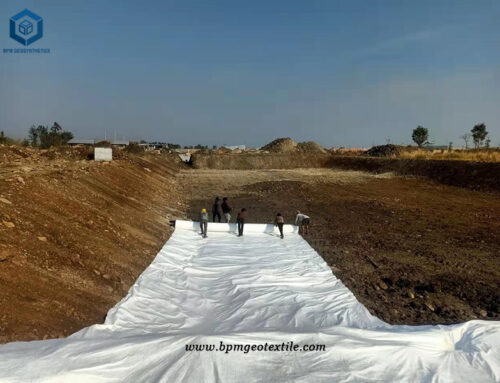Woven geotextile membrane is the kind of woven geotextile fabric which is woven and blended by two rows of parallel virgin polypropylene yarns (or tape yarn) into planar, permeable textile patters with various thickness and compactness for different applications. The base polypropylene material of woven geotextile membrane should fulfills ASTM standard requirement. Woven geotextile membrane is made from weaving monofilament, multifilament, or slit film yarns. Slit film yarns can be further subdivided into flat tapes and fibrillated yarns. There are two steps in this process of making a woven geotextile membrane. First, manufacture of the filaments or slitting the film to create yarns. Second, weaving the yarns to form the geotextile.
1.What Is Woven Geotextile Membrane?
Woven geotextile membranes can serve as a separation layer between different soil layers or materials. Geotextile Fabric is a fabric made by weaving synthetic fibers together. It provides reinforcement, stabilization, filtration, and separation functions in civil engineering and environmental applications. Its strong and durable structure makes it suitable for various construction projects where soil stability, erosion control, and filtration are essential.
BPM woven geotextile membrane is relatively light in weight, high grab strength, excellent puncture resistance, good stabilization, high ultraviolet ray resistance, high elongation, excellent stability and high tensile strength to allow for soil separation, maximum slope support, stabilization and erosion control, etc. It is widely used in in such civil environmental engineering and construction projects as roads, pavements, railroads, structures and water conservancy project, etc.
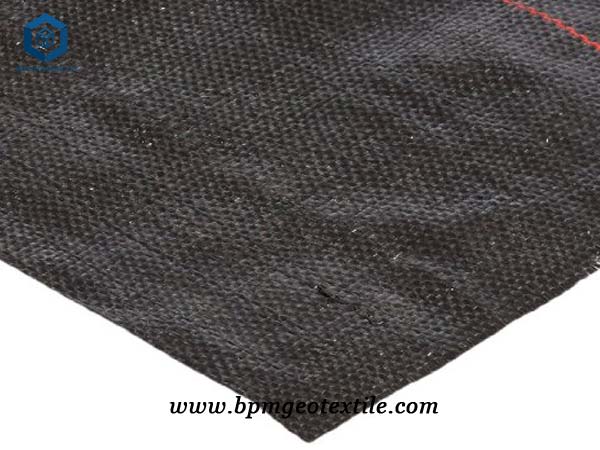
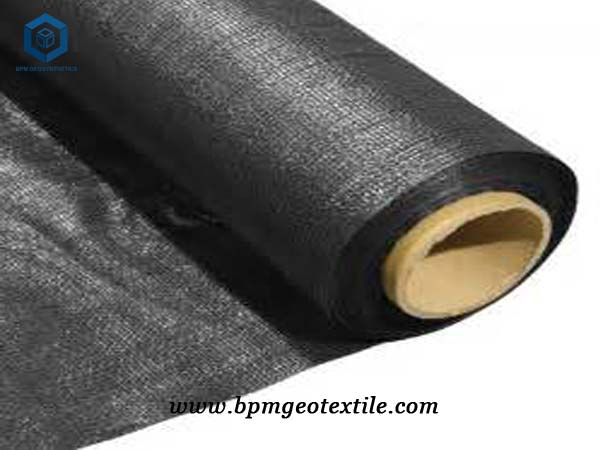
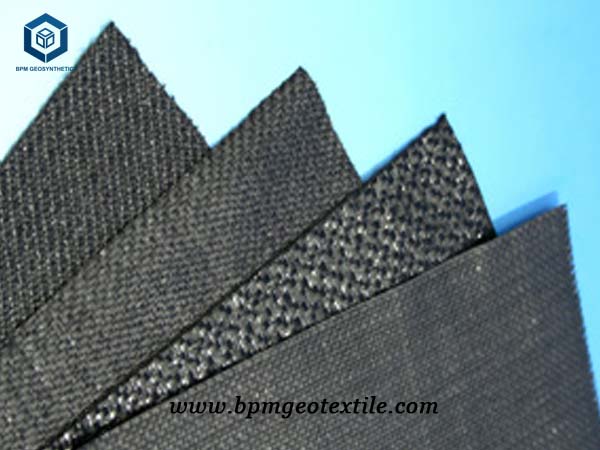
2.What Are Characteristics of Woven Geotextile Membrane?
Woven geotextile membranes possess several key characteristics that make them suitable for a wide range of civil engineering and environmental applications. Here are some of the notable characteristics of woven geotextile membranes:
2.1 Strong and Resilient
Woven geotextile membranes exhibit excellent tensile strength, enabling them to resist heavy loads and endure substantial stresses. This strength makes them ideal for reinforcing and stabilizing soil and other materials in diverse construction applications.
2.2 Long-lasting
The weaving process employed in manufacturing woven geotextile membranes results in a durable fabric that can withstand harsh environmental conditions. They are resistant to degradation caused by UV exposure, abrasion, and chemicals, ensuring their longevity.
2.3 Controlled Permeability
Geotextile membranes possess regulated permeability, facilitating the efficient flow of water and fluids through the fabric. This characteristic is crucial for applications requiring filtration, drainage, or effective water management, preventing the accumulation of hydrostatic pressure and facilitating proper drainage.
2.4 Separation and Stabilization
These membranes serve as a separation layer, preventing the mixing of different materials like fine-grained soils and coarse aggregates. This separation maintains the integrity and performance of construction projects. Additionally, they aid in stabilizing loose or weak soils by distributing loads and mitigating soil erosion.
2.5 Resistance to Biological Degradation
Geotextile membranes are typically resistant to biological degradation, safeguarding them against damage caused by microorganisms, fungi, or bacteria. This resistance ensures their long-term effectiveness and performance in different environmental conditions.
2.6 Lightweight and Easy to Install
Woven geotextile is lightweight, making them easy to handle and install. Their reduced weight simplifies transportation, lowers labor requirements, and enhances overall project efficiency.
3.What Is Woven Geotextile Membrane Used for?
Woven geotextile have a wide range of applications in civil engineering and environmental projects. Here are some common uses of woven geotextile membranes:
3.1 Soil Stabilization
Geotextile membrane is utilized to reinforce and stabilize soil in areas prone to erosion or instability. They provide tensile strength, preventing soil particle movement and enhancing the stability of embankments, slopes, and retaining walls.
3.2 Separation
BPM geotextiles act as a barrier between different soil layers or materials, ensuring their separation. By preventing the mixing of dissimilar materials, such as fine-grained soils and coarse aggregates, they maintain the integrity and performance of construction projects.
3.3 Filtration and Drainage
Woven geotextiles with controlled permeability enable efficient water filtration and drainage. They are employed in drainage systems, road construction, and erosion control projects to prevent hydrostatic pressure buildup and ensure proper water flow.
3.4 Erosion Control
Geotextile membranes are used to combat soil erosion in various applications. They are installed on slopes, riverbanks, and shorelines to stabilize soil, prevent erosion caused by water flow, and protect against sediment loss.
3.5 Road Construction
Geotextiles play a role in road construction projects, improving road surface performance and longevity. Placed between the subgrade and road base, they minimize soil movement, enhance load distribution, and prevent fine particle intrusion into the base layers.
3.6 Landfills and Waste Containment
Geotextile membranes are vital in landfill engineering and waste containment systems. They function as barriers, preventing contaminant migration, providing separation between waste layers, and facilitating proper drainage and leachate collection.
4.Case Study Of Woven Geotextile Membrane for Road Reinforcement
Slit film fabrics are commonly used for road stabilization applications but are poor choices for subsurface drainage and erosion control applications. Though the flat tape slit film yarns are quite strong, they form a fabric that has relatively poor permeability. Alternatively, fabrics made with fibrillated tape yarns have better permeability and more uniform openings than flat tape products. Monofilament wovens have better permeability, making them suitable for certain drainage and erosion control applications. High strength multifilament wovens are primarily used in reinforcement applications.
Our India customer sent us an inquiry about black woven geotextile membrane used for road reinforcement project. We sent him our woven geotextile membrane manufacturing videos, pictures and certificates. He was very satisfied with these information. Then we sent our professional geotextile quotation sheet and more details of project design by communication and negotiation quickly. Finally,he placed the order for 220 GSM woven fabric.
Specifications of Woven Geotextile Membrane for Road Reinforcement Project in India
• Specification – 220 GSM
• Each roll size– 6m×50m
• Delivery times – 6 weeks
5.About BPM
BPM had provided many types of effective and states of the art geomembranes, geotextile and other geosynthetics to over 36 countries. Our main customers are from Australia, France, Sweden, UK, Hong Kong, Hungary, New Zealand, Poland, Mexico, Ecuador, Brazil, Pakistan, Bangladesh, Thailand, Vietnam, Malaysia, Indonesia, Singapore, Philippines, Sri Lanka, India, UAE, Saudi Arabia, Qatar, Kenya, Ghana, Ethiopia, Somalia, Nigeria, South Africa, Swaziland, Mongolia etc.
BPM is also providing professional design and installation service. OEM and ODM are also available. If you have any questions or inquiries, please fill and submit the following form, we will reply as soon as possible.

